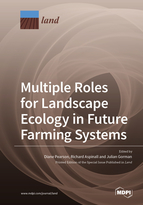Multiple Roles for Landscape Ecology in Future Farming Systems
A special issue of Land (ISSN 2073-445X).
Deadline for manuscript submissions: closed (22 November 2021) | Viewed by 39576
Special Issue Editors
Interests: sustainable landscape management; landscape ecology; environmental management; land system change; land use; GIS; environmental change; participatory research; co-production of knowledge; landscape planning and design and landscape function
Special Issues, Collections and Topics in MDPI journals
Interests: land systems science; land use; GIS; sustainability; environmental change; landscape ecology
Special Issues, Collections and Topics in MDPI journals
Special Issue Information
Dear Colleagues,
Agriculture in the coming century faces new and urgent pressures, with mounting social, environmental, and economic challenges. Climate change will alter the prevalence and capacity of farming and forestry across regions; it is likely that flooding and drought events will increase in frequency, and water quality and quantity will become increasingly problematic. Additionally, biodiversity is declining, biosecurity threats abound, market influences are changing, and there are heightened concerns around the relationship between animal protein and human health. There is also growing public intolerance for the cumulated environmental impacts from the agricultural sector, requiring a need to adopt more of a social licence to operate into the future. This is all set in a framework where there is a need to feed a growing global population, putting pressure on marginal and previously unproductive land to be considered for production or intensification.
The holistic and multidisciplinary nature of landscape ecology positions it aptly to be ready to not only address the challenges facing agriculture, but also to offer advice on how to plan, design, modify, and develop new landscapes with the best environmental, economic, and social outcomes in mind. It should be able to provide appropriate tools, approaches, and frameworks that can facilitate the action, knowledge, and advice required to help work towards the creation of future farming systems that meet societal needs, respond to the environmental challenges, and that can sit within sustainable landscapes and societies. This Special Issue will explore these contributions and discuss the evolving roles for landscape ecology in future agricultural systems.
In this Special Issue, we invite papers focusing on, but not limited to, the following topics:
- How landscape ecology can assist in the planning, design, modification, and development of new farming landscapes with the best environmental, economic, and social outcomes in mind;
- How landscape ecology can contribute towards increasing food production in the face of market and climatic variability whilst reducing environmental impacts;
- How landscape ecology can assist in the transformative change required for the socioeconomic and environmental systems of rural areas and food production for the future.
Prof. Dr. Diane Pearson
Prof. Dr. Richard Aspinall
Mr. Julian Gorman
Guest Editors
Manuscript Submission Information
Manuscripts should be submitted online at www.mdpi.com by registering and logging in to this website. Once you are registered, click here to go to the submission form. Manuscripts can be submitted until the deadline. All submissions that pass pre-check are peer-reviewed. Accepted papers will be published continuously in the journal (as soon as accepted) and will be listed together on the special issue website. Research articles, review articles as well as short communications are invited. For planned papers, a title and short abstract (about 100 words) can be sent to the Editorial Office for announcement on this website.
Submitted manuscripts should not have been published previously, nor be under consideration for publication elsewhere (except conference proceedings papers). All manuscripts are thoroughly refereed through a single-blind peer-review process. A guide for authors and other relevant information for submission of manuscripts is available on the Instructions for Authors page. Land is an international peer-reviewed open access monthly journal published by MDPI.
Please visit the Instructions for Authors page before submitting a manuscript. The Article Processing Charge (APC) for publication in this open access journal is 2600 CHF (Swiss Francs). Submitted papers should be well formatted and use good English. Authors may use MDPI's English editing service prior to publication or during author revisions.
Keywords
- agricultural landscapes
- sustainable landscapes
- landscape planning and design
- land use
- land systems
- natural capital
- ecosystem services
- socioecological systems
- cultural landscapes
Related Special Issue
- Landscapes and Sustainable Farming in Land (7 articles)








